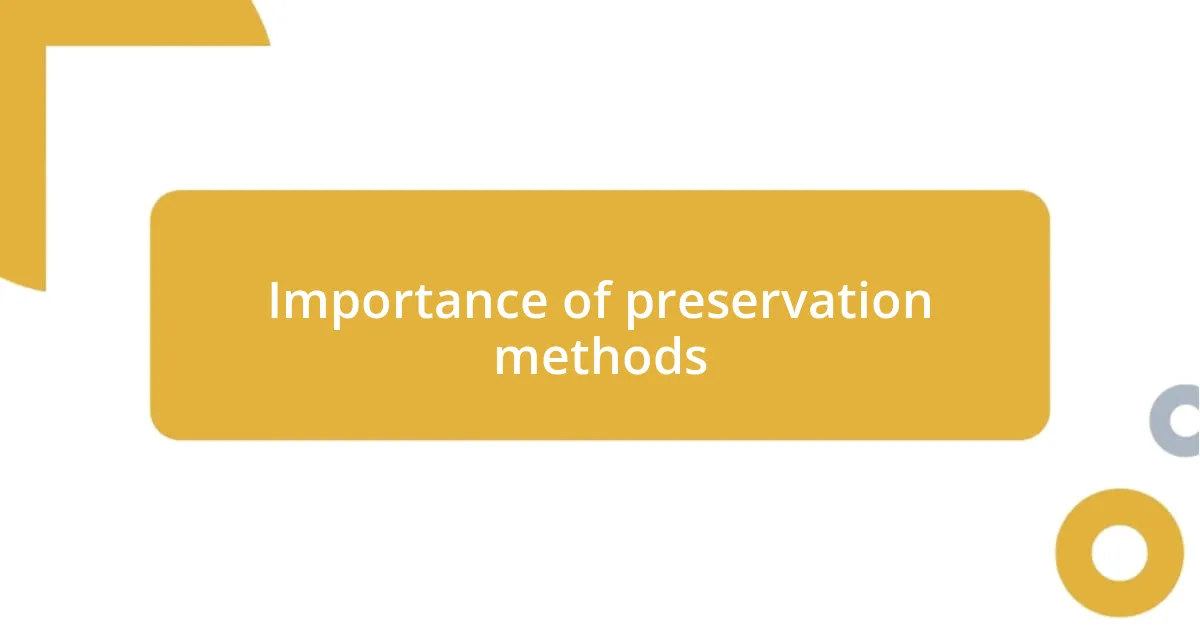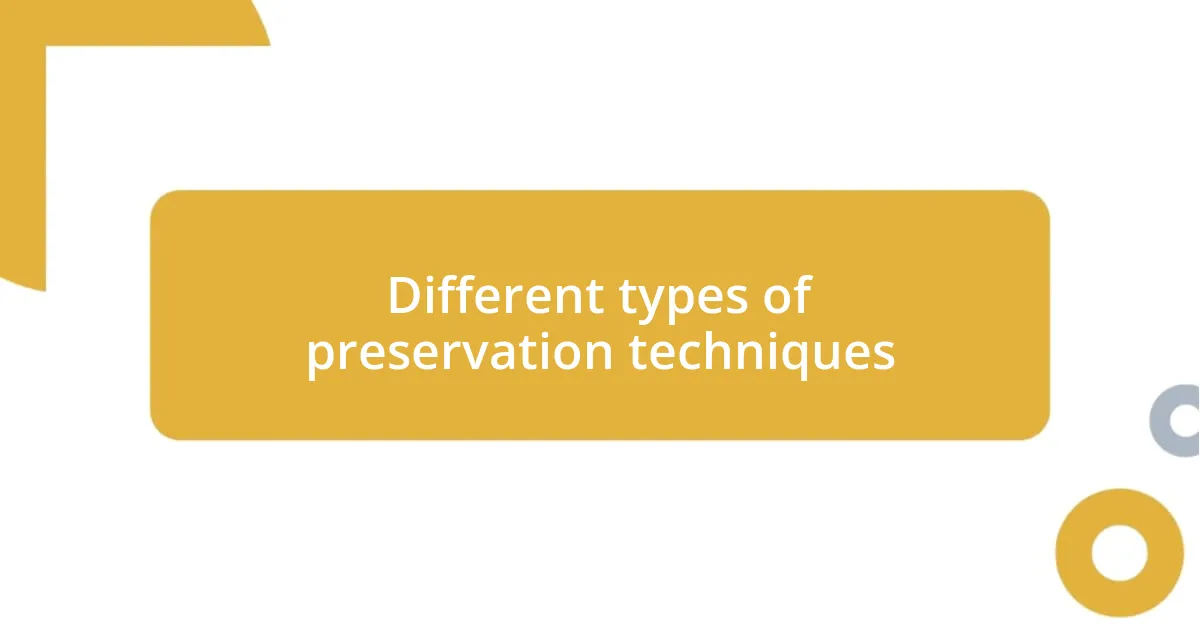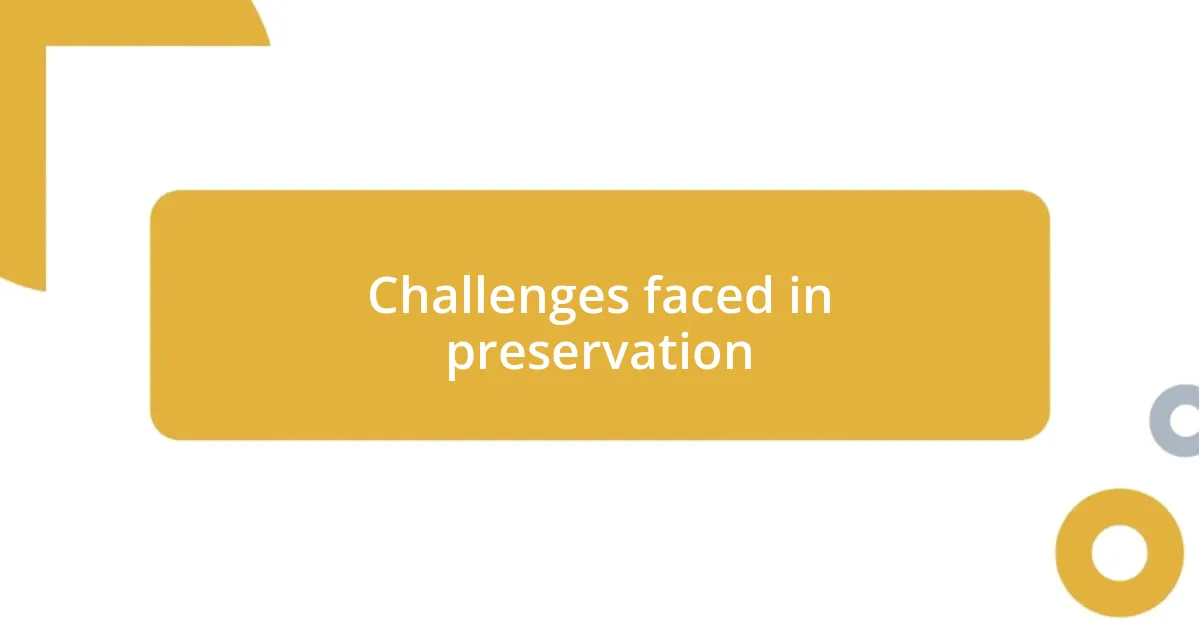Key takeaways:
- Preservation techniques like canning, fermentation, freezing, and drying allow for year-round enjoyment of seasonal produce while minimizing food waste.
- Experiencing hands-on preservation activities fosters a deeper connection to food, evoking memories and enhancing culinary creativity.
- Challenges in preservation, such as maintaining flavor balance and ensuring proper sealing, highlight the importance of attention to detail and experimentation.
- Future trends include the integration of smart technology and sustainable practices, encouraging innovative preservation methods and flavors from global cuisines.

Understanding preservation techniques
When I first delved into preservation techniques, I was taken aback by the sheer variety available. It wasn’t just about keeping food fresh; it was an art form that allowed me to reconnect with the cycle of nature. Have you ever considered how much flavor can be locked in through canning or how fermentation transforms simple ingredients into something entirely new?
One of my most memorable experiences was when I tried pickling for the first time. The anticipation while I waited for the jars to seal was palpable, filled with both excitement and uncertainty. Watching that bright green cucumber transform into a tangy delight was a revelation, making me realize just how much science and creativity intertwine in preservation techniques.
Understanding these methods on a deeper level has become essential for me, especially as I strive to minimize waste in my kitchen. It’s fascinating to see how techniques like freezing and drying can extend the life of produce while maximizing the flavors we often take for granted. So, what’s stopping you from exploring these methods in your own kitchen? Embracing preservation can change not just how we eat, but how we appreciate our food.

Importance of preservation methods
Preservation methods are crucial as they bridge the gap between seasons, allowing us to enjoy summer’s bounty even in winter. I remember the thrill of canning tomatoes at the peak of ripeness; pop a jar open in January, and it’s like time travel back to that hot afternoon in my garden. This connection to food and the seasons fosters an appreciation that goes beyond just consumption.
Moreover, these methods contribute significantly to sustainability. By preserving food, I’m actively reducing waste, an issue that weighs heavily on my conscience. I feel a profound sense of responsibility when I think about the food that might have gone to waste if not for my efforts. It’s empowering to know that with every jar I seal, I’m playing a part in creating a more sustainable food system.
Finally, employing preservation techniques enriches our culinary adventures. I can experiment with flavors and textures, transforming simple ingredients into gourmet experiences. The sheer joy of unveiling homemade jams or fermented vegetables during a dinner party always sparks conversation and admiration, proving that preservation is not just practical, but an enjoyable craft worth mastering.
| Preservation Method | Importance |
|---|---|
| Canning | Extends shelf life and allows seasonal enjoyment year-round |
| Fermentation | Enhances flavors, preserves food naturally, and promotes gut health |
| Freezing | Locks in freshness and nutritional value while reducing waste |
| Drying | Concentrates flavors and requires minimal storage space |

Different types of preservation techniques
There’s a world of preservation techniques, and I’ve had the pleasure of experimenting with many of them. One experience that stands out was attempting dehydrating fruits for the first time. As I chopped fresh peaches, the sweet aroma filled my kitchen, and I felt a connection to those long summer days when we would visit orchards. The process of circling the warm air around the peaches allowed me to capture those fleeting flavors, transforming them into crunchy snacks I could enjoy all year round.
When it comes to preservation, each method offers its own unique rewards and flavors. Here’s a quick look at some of my favorites:
- Canning: This method is a great way to lock in seasonal produce, like that overwhelming tomato harvest I had last summer. There’s something truly satisfying about filling jars and hearing the satisfying “pop” as they seal.
- Fermentation: Delving into this technique helped me explore tangy flavors. Making my own sauerkraut not only changed how I think about cabbage but also added a probiotic boost to my meals.
- Freezing: I often freeze herbs from my garden, which gives my winter dishes a fresh taste reminiscent of summer. It’s amazing how preserving something at its peak can keep its character intact.
- Drying: I recently tried drying herbs and couldn’t believe how concentrated the flavors became. It’s like capturing sunlight in a jar; the dried basil still carries that vibrant taste I love.
The beauty of these methods lies not just in their practicality, but in the memories and emotions they evoke. Each preserved jar is a capsule of time, connecting me to seasons past and flavors I’ve come to cherish.

My personal journey with preservation
As I reflect on my journey with preservation, one particular memory tugs at my heart. The first time I tried making pickles, I was overwhelmed with excitement and nerves. I remember the tangy aroma of vinegar filling my kitchen and the weight of those crisp cucumbers in my hands. It was like creating a little magic; the moment I tasted that first pickle, it transported me right back to summer barbecues with my family. Don’t you think it’s incredible how food can evoke such strong memories?
I also recall the spontaneity of experimenting with preserving herbs. One chilly autumn afternoon, I decided to try making herb-infused oils. As I combined rosemary and garlic, the scent enveloped my kitchen like a warm hug. It made me ponder: isn’t it fascinating how simple ingredients can transform into something extraordinary? That feeling of taking something fresh from my garden, and knowing that I would enjoy it during the colder months, gave me a profound sense of connection to my cooking and the cycles of nature.
With each technique I’ve explored, I’ve found that preservation isn’t just about extending shelf life; it’s about nurturing a deeper appreciation for food. I often think about how I can take a moment to pause and savor those flavors I’ve worked so hard to preserve. Whether it’s a jar of spicy pepper jelly or a batch of sweet strawberry preserves, each taste bursts with memories and emotions. Isn’t it amazing how much power we have to capture fleeting moments in a jar?

Challenges faced in preservation
One of the biggest challenges I’ve encountered in preservation is maintaining the right balance of flavors during fermentation. I remember my first batch of kimchi; I had high hopes but ended up with a batch that was too salty. It was disappointing because I could already taste the unique tanginess I wanted to achieve. This experience taught me the importance of precision. Do you ever get frustrated when your recipes don’t turn out as expected? I certainly do, but it’s all part of the learning process.
Another hurdle I’ve faced is ensuring that my canned goods have the proper seal. After a long day of canning, I left my jars on the counter only to find that a couple didn’t seal properly the next morning. That feeling was gut-wrenching — a reminder of the effort put into preserving the season’s bounty. I’ve learned to double-check my methods and pay closer attention to details. Have you ever lost a treasured dish? It’s a tough lesson, but it makes the successes even sweeter.
Lastly, storage plays a critical role in successful preservation. I recall trying to keep my dried herbs organized in a cluttered pantry. Not only did it become overwhelming, but I also lost track of what I had preserved. It made me think about how important it is to create a system that works for us. How do you keep your pantry or storage area organized? It’s these little nuggets of wisdom that can lead to smoother preservation adventures in the future.

Best practices for effective preservation
Having a solid foundation in best practices makes a world of difference in preservation. When I first started bottling my homemade sauces, I learned quickly about the importance of using sterilized jars. I remember feeling a bit overwhelmed, staring at the mountain of jars and realizing that every tiny speck of dust could lead to spoilage. It’s funny how something so simple can feel monumental when it comes to food safety, isn’t it? Ensuring that everything is properly sanitized not only boosts my confidence but also guarantees the integrity of my hard work.
Another essential practice I can’t stress enough is keeping track of what I’ve preserved. I made the mistake of labeling jars with vague terms like “fruit spread” and ended up playing a guessing game months later. It was like unwrapping a present, only to find it was something I didn’t quite want. Now, I take the time to write detailed labels, including the date and even a mini-tasting note. Have you ever had that moment where you open a jar, hoping for a taste from days gone by, and it just doesn’t live up? It’s a reminder that a bit of foresight goes a long way to ensure I can joyfully relive those flavors.
Lastly, I believe that experimentation is a best practice in its own right. Each attempt teaches us something new, even if the end result isn’t what we anticipated. I can recall blending different spices into my jams on a whim, resulting in some delightful surprises! Embracing that trial-and-error spirit allows creativity to flourish in the kitchen. Have you felt that thrill of discovering something unexpected in your cooking? It keeps the joy alive and makes every jar of preserves a unique little adventure in itself.

Future trends in preservation techniques
One exciting trend I’m noticing in preservation techniques is the rise of smart technology. The thought of using apps and gadgets to monitor fermentation temperatures or humidity levels is both thrilling and slightly overwhelming. I recently experimented with a temperature-controlled fermentation crock and found that my kimchi turned out more consistently flavorful than ever before. Have you dabbled in tech-enhanced cooking? It can really change the game!
Fermentation and preservation methods are also likely to embrace sustainability trends. I’ve started noticing more emphasis on using up food scraps and natural preservatives like kombucha. This shift not only reduces waste but also encourages creative recipes. The last time I whipped up a batch of pickled vegetable scraps, I felt a sense of fulfillment knowing I was doing my part for the planet. Can you imagine incorporating more eco-friendly practices into your preservation routines?
Lastly, I’m genuinely excited about the expansion of global flavors making their way into home preservation. More people seem to be exploring unconventional techniques borrowed from different cultures, like lacto-fermentation or fruit leather making. Last summer, I decided to try making preserved lemons after a trip to Morocco, and they added a whole new dimension to my cooking. Have you ever found inspiration in international cuisine? It’s a delightful way to keep your preservation practices vibrant and adventurous!













